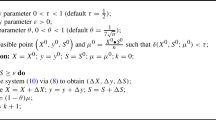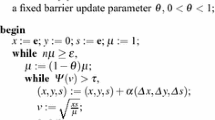Abstract
Recently the authors have proposed a homogeneous and self-dual algorithm for solving the monotone complementarity problem (MCP) [5]. The algorithm is a single phase interior-point type method; nevertheless, it yields either an approximate optimal solution or detects a possible infeasibility of the problem. In this paper we specialize the algorithm to the solution of general smooth convex optimization problems, which also possess nonlinear inequality constraints and free variables. We discuss an implementation of the algorithm for large-scale sparse convex optimization. Moreover, we present computational results for solving quadratically constrained quadratic programming and geometric programming problems, where some of the problems contain more than 100,000 constraints and variables. The results indicate that the proposed algorithm is also practically efficient.
Similar content being viewed by others
References
F. Alizadeh, "Interior point methods in semidefinite programming with applications to combinatorial optimization," SIAM J. on Optim., vol. 5, no.1, 1995.
E.D. Andersen, "Finding all linearly dependent rows in large-scale linear programming," Optimization Methods and Software, vol. 6, pp. 219-227, 1995.
E.D. Andersen and K.D. Andersen, "Presolving in linear programming," Math. Programming, vol. 71, no.2, pp. 221-245, 1995.
E.D. Andersen and X. Xu, "The QMPS format for quadratically constrained optimization problems," Technical Report, Department of Management, Odense University, Denmark, 1996. Available from: http://www.ou.dk/busieco/man/faculty/eda.html.
E.D. Andersen and Y. Ye, "On a homogeneous algorithm for the monotone complementarity problem," Technical Report, Department of Management Sciences, The University of Iowa, 1995. Revised November 1996, to appear in Mathematical Programming.
E.D. Andersen and Y. Ye, "On a homogeneous algorithm for a monotone complementarity problem with nonlinear equality constraints,” in Complementarity and Variational Problems: State of the Art, M.C. Ferris and J.S. Pang (Eds.), SIAM: Philadelphia, PA, USA, 1997.
K.D. Andersen, "Minimizing a sum of norms (Large-scale solutions of symmetric positive definite linear systems)," Ph.D. Thesis, Odense University, 1995.
K. Anstreicher and J.-P. Vial, "On the convergence of an infeasible primal-dual interior-point method for convex programming," Optimization Methods and Software, vol. 3, pp. 273-283, 1994.
O. Bahn, J.L. Goffin, J.-Ph. Vial, and O. Du Merle, "Experimental behaviour of an interior point cutting plane algorithm for convex programming: An application to geometric programming," Discrete Appl. Math., vol. 49, pp. 2-23, 1994.
D.P. Baron, "Quadratic programming with quadratic constraints," Naval Res. Logist. Quart., vol. 19, pp. 253-260, 1972.
M.S. Bazaraa, H.D. Sherali, and C.M. Shetty, Nonlinear Programming: Theory and Algorithms, 2nd edition, John Wiley and Sons: New York, 1993.
C. Beightler and D.T. Phillips, Applied Geometric Programming, John Wiley and Sons: New York, 1976.
A. Ben-Tal and A. Nemirovskii, "Potential reduction polynomial time method for truss topology design," SIAM J. on Optim., vol. 4, no.3, 1994.
K.M. Bretthauer and B. Shetty, "The nonlinear resource allocation problem," Oper. Res., vol. 43, no.4, pp. 670-683, 1995.
R.W. Cottle, J.-S. Pang, and R.E. Stone, "The linear complementarity problem," Computer Science and Scientific Computing, Academic Press: San Diego, 1992.
E. de Klerk, C. Roos, and T. Terlaky, "Initialization in semidefinite programming via a self-dual skew-symmetric embedding," Technical Report 96-10, Faculty of Mathematics and Informatics, Delft University of Technology, 1996.
R.S. Dembo, "Second-order algorithms for posynomial geometric programming dual, Part I: Analysis," Math. Programming, vol. 17, pp. 156-175, 1979.
D. den Hertog, J. Kaliski, C. Roos, and T. Terlaky, "A logarithmic barrier cutting plane method for convex programming," in Annals of Operations Research, I. Maros and G. Mitra (Eds.), Baltzer Science Publishers: Amsterdam, The Netherlands, vol. 58, pp. 69-98, 1995.
J.E. Dennis, Jr. and R.B. Schnabel, "Numerical methods for unconstrained optimization and nonlinear equations," Prentice-Hall, Inc.: Englewood Cliffs, NJ 07632, USA, 1983.
R.J. Duffin, E.L. Peterson, and C. Zener, Geometric Programming, John Wiley and Sons: New York, 1969.
E. Phan-huy-Hao, "Quadratically constrained quadratic programming: Some applications and a method for solution," Zeitschrift für Operations Research, vol. 26, pp. 105-119, 1982.
A.S. El-Bakry, R.A. Tapia, T. Tsuchiya, and Y. Zhang, "On the formulation and theory of the primal-dual Newton interior-point method for nonlinear programming," J. Optim. Theory Appl., vol. 89, no.3, pp. 507-541, 1996.
A.V. Fiacco and G.P. McCormick, Nonlinear Programming: Sequential Unconstrained Minimization Techniques, John Wiley and Sons: New York, 1968.
R.W. Freund and F. Jarre, "A QMR-based interior-point algorithm for solving linear programs," Math. Programming, vol. 76, no.1, pp. 183-210, 1997.
P.E. Gill, W. Murray, M.A. Saunders, J.A. Tomlin, and M.H. Wright, "On the projected Newton barrier methods for linear programming and an equivalence to Karmarkar’s projective method," Math. Programming, vol. 36, pp. 183-209, 1986.
J.-L. Goffin, J. Gondzio, R. Sarkissian, and J.-P. Vial, "Solving nonlinear multicommodity flow problems by the analytic center cutting plane method," Math. Programming, vol. 76, no.1, pp. 131-154, 1997.
J. Gondzio, R. Sarkissian, and J.-P. Vial, "Using an interior point method for the master problem in a decomposition approach," Technical Report 1995. 30, Logilab, HEC Geneva, Section of Management Studies, University of Geneva, 1995. To appear in European Journal of Operations Research.
O. Güler, "Existence of interior points and interior paths in nonlinear monotone complementarity problems," Math. Oper. Res., vol. 18, pp. 148-162, 1993.
F. Jarre, "On the convergence of the method of analytic centers when applied to convex quadratic programs," Math. Programming, vol. 49, pp. 341-358, 1991.
F. Jarre, M. Kocvara, and J. Zowe, "Interior point methods for mechanical design problems," Technical Report 173, Institut für Angewandte Mathematik, Universität Erlangen-Nürnburg, 1996.
N. Karmarkar, "A polynomial-time algorithm for linear programming," Combinatorica, vol. 4, pp. 373-395, 1984.
M. Kojima, N. Megiddo, and S. Mizuno, "A primal-dual infeasible-interior-point algorithm for linear programming," Math. Programming, vol. 61, pp. 263-280, 1993.
M. Kojima, S. Mizuno, and A. Yoshise, "A primal-dual interior point algorithm for linear proramming," in Progress in Mathematical Programming: Interior-Point Algorithms and Related Methods, N. Megiddo (Ed.), Springer Verlag: Berlin, 1989, pp. 29-47.
K.O. Kortanek, F. Potra, and Y. Ye, "On some efficient interior point methods for nonlinear convex programming," Linear Algebra Appl., vol. 152, pp. 169-189, 1991.
K.O. Kortanek and X. Xu, "Numerical experiments with XGP: An optimizer for geometric programming and some comparisons with other solvers," Technical Report, Department of Management Sciences, The University of Iowa, 1995.
K.O. Kortanek, X. Xu, and Y. Ye, "An infeasible interior-point algorithm for solving primal and dual geometric programs," Math. Programming, vol. 76, no.1, pp. 155-181, 1997.
I.J. Lustig, R.E. Marsten, and D.F. Shanno, "Interior point methods for linear programming: Computational state of the art," ORSA J. on Comput., vol. 6, no.1, pp. 1-15, 1994.
S. Mehrotra, "On the implementation of a primal-dual interior point method," SIAM J. on Optim., vol. 2, no.4, pp. 575-601, 1992.
S. Mehrotra and J. Sun, "A method of analytic centers for quadratically constrained convex quadratic programming," SIAM J. Numer. Anal., vol. 28, no.2, pp. 529-544, 1991.
Y. Nesterov and A. Nemirovskii, Interior-Point Polynomial Algorithms in Convex Programming, 1st edition, SIAM: Philadelphia, PA, 1994.
Y. Nesterov and M. Todd, "Self-scaled barries and interior point methods for convex programming," Technical Report, CORE, Lovain-la-Neuve, 1994. Discussion paper 9462.
F.A. Potra and R. Sheng, "Homogeneous interior-point algorithms for semidefinite programming," Technical Report 82/1995, Department of Mathematics, The University of Iowa, 1995.
L. Vandenberghe and S. Boyd, "Semidefinite programming," SIAM Rev., vol. 38, no.1, pp. 49-95, 1996.
R.J. Vanderbei, "Symmetric quasi-definite matrices," SIAM J. on Optim., vol. 5, no.1, 1995.
R.J. Vanderbei and T.J. Carpenter, "Symmetric indefinite systems for interior point methods," Math. Programming, vol. 58, pp. 1-32, 1993.
J.-P. Vial, "Computational experience with a primal-dual algorithm for smooth convex programming," Optimization Methods and Software, vol. 3, pp. 273-283, 1994.
X. Xu, P.-F. Hung, and Y. Ye, "A simplified homogeneous and self-dual linear programming algorithm and its implementation," Annals of Operations Research, vol. 62, pp. 151-171, 1996.
G. Xue and Y. Ye, "An efficient algorithm for minimizing a sum of Euclidean norms with applications," Technical Report, Department of Computer Science and Electrical Engineering, The University of Vermont, June 1995. University of Vermont Research Report, CSEE/955/01-01, to appear in SIAM J. on Optimization.
H. Yamashita and H. Yabe, "Superlinear and quadratic convergence of some primal-dual interior point methods for constrained optimization," Math. Programming, vol. 75, no.3, pp. 377-397, 1996.
Y. Ye, M.J. Todd, and S. Mizuno, "An O(√nL)-iteration homogeneous and self-dual linear programming algorithm," Math. Oper. Res., vol. 19, pp. 53-67, 1994.
Author information
Authors and Affiliations
Rights and permissions
About this article
Cite this article
Andersen, E.D., Ye, Y. A Computational Study of the Homogeneous Algorithm for Large-scale Convex Optimization. Computational Optimization and Applications 10, 243–269 (1998). https://doi.org/10.1023/A:1018369223322
Issue Date:
DOI: https://doi.org/10.1023/A:1018369223322




